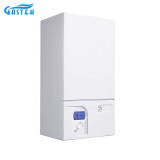How does a gas boiler work step by step?
2024-07-08
A gas boiler is a common heating system that uses natural gas to heat water, providing central heating and sometimes hot water for taps. Here’s a step-by-step explanation of how a typical gas boiler works:

1. Thermostat Activation:
- The process begins when the thermostat detects that the temperature has dropped below a preset level and signals the boiler to turn on.
2. Gas Valve Opens:
- The gas valve in the boiler opens to allow natural gas to flow to the burner.
3. Ignition:
- An ignition system (either a pilot light or an electronic igniter) ignites the gas. This creates a flame in the burner.
4. Heat Exchanger:
- The burner heats up the heat exchanger, which is a series of coils or fins that transfer heat from the flame to the water passing through them.
5. Water Circulation:
- A pump circulates cold water from the heating system through the heat exchanger. As the water passes through the heat exchanger, it absorbs heat from the gas flame.
6. Heated Water Distribution:
- The now-hot water is circulated throughout the house via a network of pipes to radiators or underfloor heating systems, or it is stored in a hot water tank for use in taps and showers.
7. Exhaust Flue:
- The combustion process produces exhaust gases, including carbon dioxide and water vapor. These gases are expelled outside through a flue.
8. Thermostat Monitoring:
- The thermostat continually monitors the room temperature. Once the desired temperature is reached, it signals the boiler to shut off the gas supply and turn off the burner.
9. Standby Mode:
- The boiler remains in standby mode until the thermostat detects that the temperature has dropped again, at which point the cycle repeats.
Safety and Efficiency Features
- Pressure Relief Valve:
- To prevent excessive pressure build-up, boilers are equipped with a pressure relief valve that releases water if the pressure gets too high.
- Expansion Tank:
- This tank accommodates the expansion and contraction of water as it heats and cools, helping to maintain consistent pressure.
- Condensing Boilers:
- Modern condensing boilers capture additional heat from the exhaust gases, making them more efficient. This process involves cooling the exhaust gases enough to condense the water vapor, releasing latent heat which is then used to heat the water further.
Understanding these steps helps in both the operation and maintenance of a gas boiler, ensuring it runs efficiently and safely.


